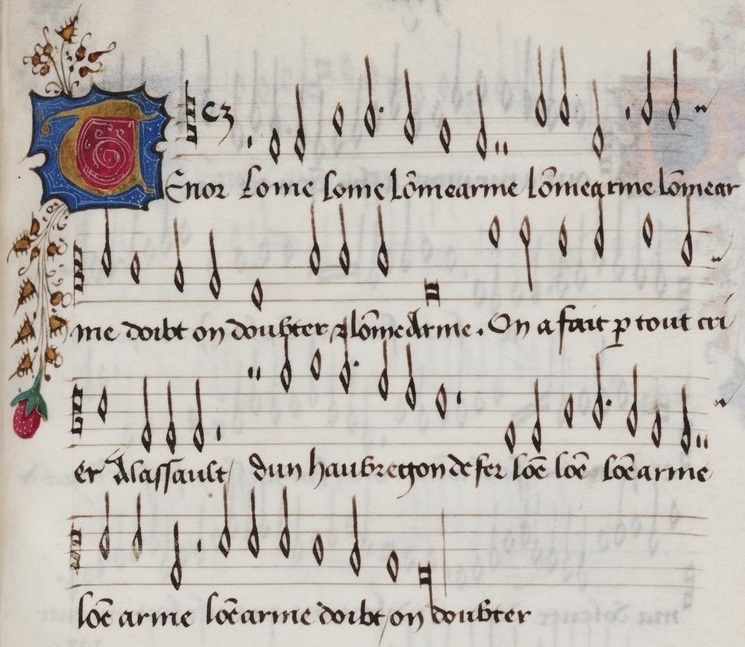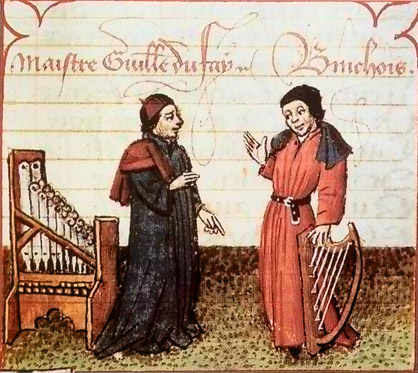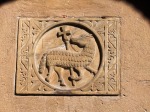Tags
L'Homme armé, Liturgical Music, madrigals, music, polyphony, Sacred & Secular, the Franco-Flemish School, the Venetian School

In the 15th century, musical compositions, both liturgical and secular, often blended several independent voices. Such compositions are labelled polyphonic. Polyphony is a musical texture blending independent voices as do Barbershop quartets.
Secular madrigals, songs in the mother (madre, Spanish) tongue, had been monophonic (one voice), but they were a form used in the development of polyphonic music. So was the Motet, liturgical music. Polyphony could at times blend more than the soprano, alto, tenor and bass (SATB), the four voices we are most familiar with. But more importantly, a Mass by Guillaume Du Fay combined the sacred and the secular. The Ordinary of the Mass was set to L’Homme armé (the armed man) a secular theme. A Mass’ permanent components constitute the Ordinary of the Mass.
Guillaume Du Fay (5 August 1397 – 27 November 1474), the most prominent composer of the 15th century, was associated with the Burgundian School. The Burgundian School was a close predecessor to the Franco-Flemish School. In the 15th century and during most of the 16th century, the Netherlands were the cultural hub of Europe. For instance, Adrian Williaert (c. 1490 – 7 December 1562), of the Franco-Flemish school, would be a teacher in Venice. He founded the Venetian School.
L’Homme armé (Wikipedia) was a very popular tune. “Over 40 settings of the Ordinary of the Mass using the tune L’Homme armé survive from the period between 1450 and the end of the 17th century.” (See L’Homme armé, Wikipedia.)
Du Fay set the Missa L’Homme armé to a cantus firmus “a pre-existing melody forming the basis of a polyphonic composition” (Wikipedia). However, the pre-existing melody was L’Homme armé, the armed man.
Composers still write sacred music. Examples are Benjamin Britten (22 November 1913 – 4 December 1976) and John Rutter (b. 1945). Earlier, Hector Berlioz (11 December 1803 – 8 March 1869) wrote his Grande Messe des morts or Requiem.
In fact, L’Homme armé is still used. Pieces on L’Homme armé are listed in its Wikipedia entry. British composer Peter Maxwell Davies composed “a parody mass Missa super L’Homme armé (1968, revised 1971).” Canadian pianist and composer Marc-André Hamelin (b. 1961) wrote Toccata on “L’Homme Armé” “on commission by the Van Cliburn Foundation for the Fifteenth Van Cliburn International Piano Competition. Every competitor was required to perform it in the preliminary stage of the competition.” (See L’Homme armé, Wikipedia.)
I should also mention rock opera Jesus Christ Superstar, with music by Andrew Lloyd-Webber (b. 1948) and lyrics by Tim Rice (b. 1944). The rock opera does not use L’Homme armé, but it is a theater musical based on a Christian theme.
One never forgets L’Homme armé.
RELATED ARTICLES
- Feasts & Liturgy (page)
—ooo—
Love to everyone 💕

© Micheline Walker
1st April 2021
WordPress



